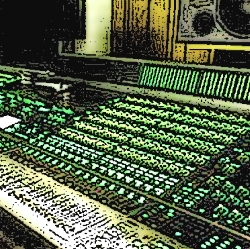
Mastering done well will prepare mixes to sound good on any variety of playback systems.
Planning on having your music played on the radio? Mastering will also prepare your music for air.
Sadly, the majority of mastering sessions I do are of files that are delivered in the wrong format. The mastering engineer can’t be expected to work miracles. Remember, garbage in = garbage out. Songs improperly handled in the mix process can prevent the music from ever being broadcast ready or sound good on any system.
There are three common mistakes made that tie the mastering engineer’s hands behind his back and literally make it impossible to do the job right. Avoiding these pitfalls will guarantee a far superior sound.
1. Mix Levels
I see red. I press play and the bus meters immediately peak in the red.
This is a deal breaker. Most adjustments made in the mastering process induce gain EQ, compression, limiting. If I see red, the level has already peaked and there is no room left to add gain. Use the master fader in your DAW to monitor the output level.
Some systems, like Pro Tools, require you to create a master fader for your session. This is one of the mix engineer’s most valuable tools. Keep an eye on the final output level of the master fader peaks should not exceed 5dB…or better yet, 10dB. If the original recording is high-def, no resolution will be lost by leaving 10dB of headroom.
2. Bus Compression
I love the sound of a good stereo bus compressor.
However, there is such a thing as too much. Or, worse yet, limiting the stereo bus instead of compressing it. You cannot uncompress or unlimit a mix.
Expanders could help in this situation, but then you’re working backwards trying to undo what was done in the mix, which, by the way, will never sound the same.
Compressing or limiting the mix should not be overdone. If the waveform of the final mix going to the mastering studio looks like a stick of butter, it’s wrong. Having said that, creating a heavily compressed or limited mix just to listen to is fine, but that should not be the version that goes to the mastering studio.
3. Delivery Method
Files should NEVER be delivered by way of audio CD…EVER!
What’s wrong with an audio CD, you ask?
To burn an audio CD, the file’s sample rate must be 44.1k and bit depth must be 16 bit. That is the only format an audio CD can possibly be.
With all of the high resolution options available today, why deliver the mixes in a format established in the 1970s? And, assuming the original recording was high def, were the files put on that CD properly converted to the 44.1k sample rate and/or properly dithered down to 16 bit?
If you burned your final mixes to CD, pop your disc in your car’s CD player on your way to the mastering studio. If it plays, it is an audio CD. Turn the car around and go back to the mixing studio to get those files in the proper format.
The only type of CD acceptable is a data disc. A data disc can have audio files of any format burned to it, an audio CD can only exist in that one format. If it is a data disc it won’t play in a CD player, so if you can play it, it’s wrong.
Mix files in the proper format can also be delivered by way of hard drive, USB flash drive or uploaded to some type of FTP server such as Dropbox or Sendspace. If the files are uploaded they should not be zipped first. Zipping requires the files to be data compressed causing a whole new set of problems for the mastering engineer.
The most advanced recording schools practice preparing files for mastering in this way. Omega Studios’ School of Applied Recording Arts and Sciences just happens to be one of them. As an audio engieering student of a seasoned audio engineer, making sure that you avoid the mastering pitfalls I reviewed will guarantee a far superior sound.
Read and comment on the original article here.
Jim Curtis is chief engineer at Omega Studios and a Pro Tools HD expert-certified recording engineer with over 17 years of in-studio experience. His credits include David Archuleta, Dru Hill, Radiohead, Third Eye Blind, Lou Reed, Blindboys of Alabama, and NBC Sports. Jim teaches Pro Tools techniques at Omega as part of the Audio Production Techniques and Audio for Film and Television programs, as well as all levels of recording studio instruction.















